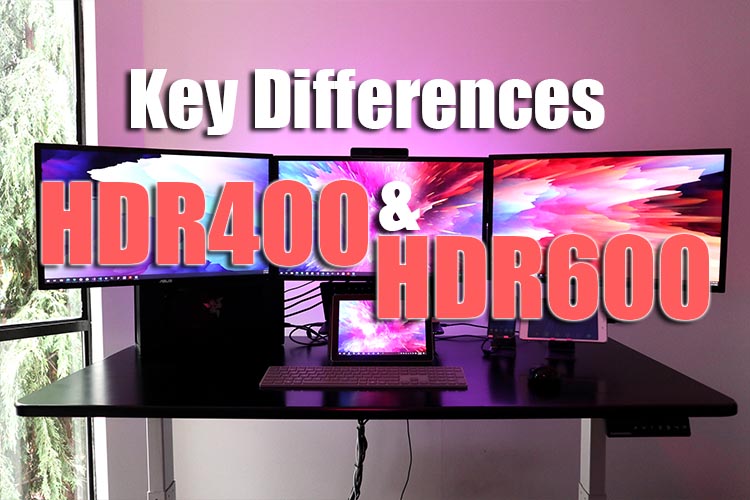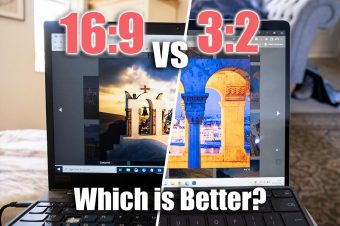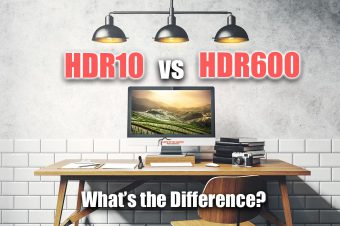When comparing HDR400 vs HDR600, the difference is that HDR 400 offers lower minimum brightness of 400cd/m2, while HDR 600 gives minimum brightness of 600cd/m2, plus local dimming and a wide color gamut for improved contrast and colors.
HDR refers to high dynamic range, which is the range between the brightest and darkest components of an image. HDR makes it possible for monitors, laptops and projectors to provide a better visual quality to viewers by increasing contrast and improving color.
When the range of the lightest and darkest parts of an image increases, you are able to see much greater detail in the images.
The term HDR is very broad and doesn’t have a very specific definition, which means that many screens are marketed as HDR even though they do not really support HDR images.
It also becomes difficult to understand or identify the differences between different specifications in HDR. If you are confused about the differences between HDR400 and HDR600, read on for a detailed breakdown of how they fare against each other.
What Is HDR400?
HDR400 is a certification of screens. It basically means that the screen has a minimum peak luminance or brightness of 400 cd/m2 or 400 nits.
When you see a number after HDR in screen specifications, it refers to the brightness, contrast ratio, color quality and other details regarding the quality of the screen. If you ask any AV expert, HDR 400 is the bare minimum when it comes to screen quality, as below this colors can tend to lose contrast and images can look washed out.
Screen quality improves as the HDR version incrementally increase, but HDR400 is the starting point in screen quality. The prices reflect the quality of the screen, so HDR400 screens are much more affordable than more advanced models.
HDR400 is the only HDR standard that doesn’t offer a wide color gamut (WCG) color range. Every classification after HDR400 has a WCG color range. HDR400 used the sRGB color range, which is pretty limited in today’s day and age, but is the common Internet standard.
If you’re a professional looking for a new monitor, then HDR 400 probably won’t cut it.
Read More:
What Is HDR600?
HDR600 is a screen specification that means that the screen can support a minimum peak brightness of 600 nits. As mentioned, there is no official qualification for HDR screens, so there is no way to verify the exact quality and color capability of the screen.
It uses a wide color gamut color range and gives a much better visual quality than HDR400. The color accuracy is better since the range of the brightest and darkest components of the image is greater.
The contrast is also better, which gives you more detailed images. However, the price of an HDR600 screen will obviously be higher than an HDR400 screen.
Key Differences between HDR400 and HDR600

HDR 400 vs HDR 600 are quite similar in the kind of image quality they provide, but there are a few key differences between them as specifications of HDR changed in subsequent models after the HDR400.
Here’s how they differ from each other:
- Peak Brightness: The most obvious difference is the peak brightness level—HDR400 has a minimum peak luminance of 400 nits whereas HDR600 has a minimum peak luminance of 600 nits.
This means that HDR600 has a greater limit of brightest and darkest spots it can incorporate than HDR400. - Color Range: Color range refers to the range of colors that a screen is able to reproduce that are visible to the naked eye.
HDR400 still uses the standard sRGB color gamut. HDR 600 has wide color gamut, which means it has superior and more accurate colors.
- Global or Local Dimming: HDR400 has global dimming, which means that the entire screen has only one overall dimming setting. HDR600 has local dimming which also gives better contrast to the image, as different parts of the screen can be dimmed at different rates.
You can get a sense for the differences between HDR 400 and HDR 600 in the video below, although you should note that it can be difficult to compare them from a video alone.
Display HDR 400 vs 600 and the VESA Standard
It’s important to separate those screens that are truly hit their HDR standards from those that manufacturers only claim hit these standards, with this being done through carefully reading the marketing terminology used.
On their own, both HDR 400 and HDR 600 are fairly meaningless. Although you could expect monitors from both standards to hit 400 cd/m2 and 600 cd/m2 in luminance respectively, you have no idea if this is a sustained test of the whole screen, a partial test of the screen center or a flash test.
Consequently, any screen that is solely described as “HDR400” or “HDR600” might not offer you the performance that you expect, as this terminology means that they have not been independently verified.
The only organisation that is able to properly measure whether a screen hits HDR400 or 600 is VESA, a non-profit that rigourously tests monitors supplied by manufacturers according to their own specifications.
These specifications are under the DisplayHDR name.
Unfortunately, this is often shortened by consumers to simply “HDR”, meaning that when manufacturers use terms like HDR600, consumers assume that this means the screen hits the official DisplayHDR600 standard, when in fact the screen doesn’t.
If, on the other hand, a screen has a VESA certified DisplayHDR 600 certification (which will be shown in the marketing materials) then it definitely will meet the official standard (although you should watch out for some manufacturers even trying to cheat at this).
This DisplayHDR certification means that a monitor is guaranteed to hit a certain brightness level in both a 10% center patch test, a flash test, and a sustained 30 minute full screen test, plus it also specifies a certain color gamut, global or local dimming, and many other technical criteria.
Therefore, you should always look out for VESA Certified DisplayHDR 400 or 600 to ensure that your screen is really hitting the standard, and not a sub-standard made up by a manufacturer.
Wrapping Up: HDR 400 vs 600
Technically speaking, there is not too much of a difference in the specifications between HDR400 and HDR600. However, there is no doubt that HDR600 is of superior screen quality.
The specifications of HDR400 are pretty basic and available on almost all screens nowadays. If you are looking for better quality, HDR600 is definitely the way to go.
Read More:
What’s the best laptop for photo editing on a budget?
What’s the best photo editing monitor under $500?






Leave a Reply